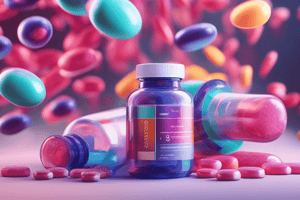Podcast
Questions and Answers
What is the primary action of antipsychotic medications?
What is the primary action of antipsychotic medications?
- Block dopamine receptors (correct)
- Increase serotonin levels in the brain
- Reduce GABA activity
- Enhance norepinephrine transmission
Which condition is commonly treated with lithium?
Which condition is commonly treated with lithium?
- Major depressive disorder
- Generalized anxiety disorder
- Attention deficit hyperactivity disorder (ADHD)
- Bipolar disorder (correct)
What is a common side effect associated with antipsychotic medications?
What is a common side effect associated with antipsychotic medications?
- Weight loss
- Sedation (correct)
- Increased libido
- Hyperactivity
Which laboratory test is crucial for monitoring patients on lithium therapy?
Which laboratory test is crucial for monitoring patients on lithium therapy?
Which type of antipsychotic is more likely to cause metabolic side effects?
Which type of antipsychotic is more likely to cause metabolic side effects?
What is a significant concern with long-term use of antipsychotic medications in terms of patient health outcomes?
What is a significant concern with long-term use of antipsychotic medications in terms of patient health outcomes?
Which pharmacological mechanism is often associated with atypical antipsychotics?
Which pharmacological mechanism is often associated with atypical antipsychotics?
Which of the following is a contraindication for administering lithium?
Which of the following is a contraindication for administering lithium?
Which blood parameter is typically monitored to assess toxicity in patients on lithium therapy?
Which blood parameter is typically monitored to assess toxicity in patients on lithium therapy?
What is a notable metabolic side effect that can arise from the use of certain antipsychotic medications?
What is a notable metabolic side effect that can arise from the use of certain antipsychotic medications?
Flashcards are hidden until you start studying
Study Notes
Antipsychotics Overview
- Antipsychotics are primarily used to treat schizophrenia and other psychotic disorders.
- They can be classified into two categories: typical (first-generation) and atypical (second-generation) antipsychotics.
- Typical antipsychotics mainly block dopamine receptors, leading to a decrease in positive symptoms like hallucinations and delusions.
- Atypical antipsychotics target both dopamine and serotonin receptors, addressing positive and negative symptoms (e.g., social withdrawal, lack of emotion).
Typical Antipsychotics
- Common examples include haloperidol and chlorpromazine.
- Side effects include extrapyramidal symptoms (EPS), such as tremors and rigidity, and tardive dyskinesia, which can be irreversible.
- Monitoring is essential due to potential weight gain, metabolic syndrome, and prolonged QT intervals.
Atypical Antipsychotics
- Examples include risperidone, olanzapine, and quetiapine.
- These drugs are known for a lower incidence of EPS compared to typical antipsychotics.
- Side effects may include sedation, metabolic syndrome, and increased risk of diabetes.
Lithium Overview
- Lithium is a mood stabilizer primarily used in treating bipolar disorder, particularly for manic episodes and maintenance therapy.
- Therapeutic range is narrow, requiring regular monitoring of serum levels to avoid toxicity (often between 0.6-1.2 mEq/L).
- Side effects can include weight gain, thyroid dysfunction, and renal impairment.
Monitoring and Management
- Regular monitoring of liver function, renal function, and thyroid levels is crucial for patients on lithium.
- Signs of lithium toxicity include tremors, confusion, and gastrointestinal symptoms.
Important Considerations
- Antipsychotics can interact with a variety of medications. Always review patient's medication history.
- In patients with a history of substance abuse, careful selection of antipsychotics and mood stabilizers is essential.
- Patient education on the recognition of side effects and adherence to medication regimens is vital for effective management.
Conclusion
- Effective management of antipsychotics and lithium involves understanding their mechanisms, side effects, and the importance of ongoing monitoring.
- Pharmacological choices should be individualized based on clinical presentation and patient history.
Antipsychotics Overview
- Antipsychotics are primarily used to treat schizophrenia and other psychotic disorders.
- They can be classified into two categories: typical (first-generation) and atypical (second-generation) antipsychotics.
- Typical antipsychotics mainly block dopamine receptors, leading to a decrease in positive symptoms like hallucinations and delusions.
- Atypical antipsychotics target both dopamine and serotonin receptors, addressing positive and negative symptoms (e.g., social withdrawal, lack of emotion).
Typical Antipsychotics
- Common examples include haloperidol and chlorpromazine.
- Side effects include extrapyramidal symptoms (EPS), such as tremors and rigidity, and tardive dyskinesia, which can be irreversible.
- Monitoring is essential due to potential weight gain, metabolic syndrome, and prolonged QT intervals.
Atypical Antipsychotics
- Examples include risperidone, olanzapine, and quetiapine.
- These drugs are known for a lower incidence of EPS compared to typical antipsychotics.
- Side effects may include sedation, metabolic syndrome, and increased risk of diabetes.
Lithium Overview
- Lithium is a mood stabilizer primarily used in treating bipolar disorder, particularly for manic episodes and maintenance therapy.
- Therapeutic range is narrow, requiring regular monitoring of serum levels to avoid toxicity (often between 0.6-1.2 mEq/L).
- Side effects can include weight gain, thyroid dysfunction, and renal impairment.
Monitoring and Management
- Regular monitoring of liver function, renal function, and thyroid levels is crucial for patients on lithium.
- Signs of lithium toxicity include tremors, confusion, and gastrointestinal symptoms.
Important Considerations
- Antipsychotics can interact with a variety of medications. Always review patient's medication history.
- In patients with a history of substance abuse, careful selection of antipsychotics and mood stabilizers is essential.
- Patient education on the recognition of side effects and adherence to medication regimens is vital for effective management.
Conclusion
- Effective management of antipsychotics and lithium involves understanding their mechanisms, side effects, and the importance of ongoing monitoring.
- Pharmacological choices should be individualized based on clinical presentation and patient history.
Studying That Suits You
Use AI to generate personalized quizzes and flashcards to suit your learning preferences.




